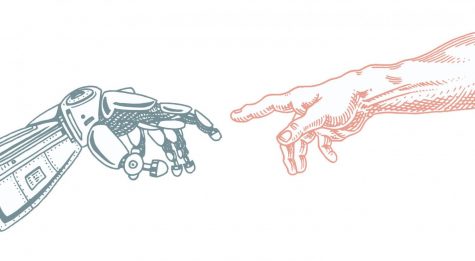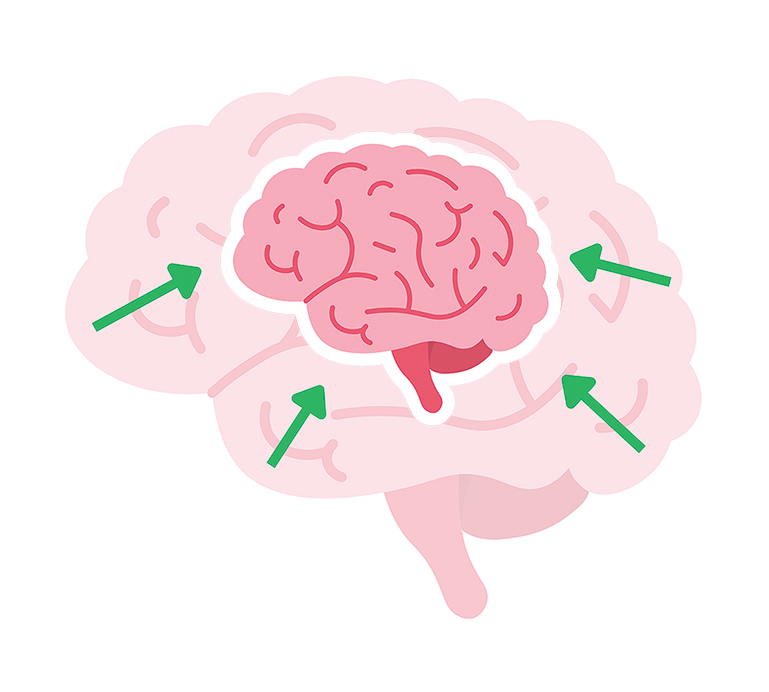An Enhanced Life: How the future of transhumanist values could change bodies, minds and society’s norms
How the future of transhumanist values could change bodies, minds and society’s norms
November 18, 2019
 The year is 2064. The New York Yankees are playing against the St. Louis Cardinals in the World Series, and pitcher Jackson Armani* stands on the mound with a stoic glare towards his catcher, who flashes signs and taps his mask. Armani winds up, and the ball leaves his hand in a blur of metal and reflective light. His bionic arm shines under the hot sun, and the ball smacks the glove at speeds of 108 miles per hour. Onlookers record the scene through their contact lenses, and the feed spreads through Twitter like wildfire. Still, others pay for hot dogs at the concession stands through metal chips in their wrists. Bathroom doors are opened with the wave of a hand, and the hustle and bustle of people in the crowd is a constant flicker of light and sound.
The year is 2064. The New York Yankees are playing against the St. Louis Cardinals in the World Series, and pitcher Jackson Armani* stands on the mound with a stoic glare towards his catcher, who flashes signs and taps his mask. Armani winds up, and the ball leaves his hand in a blur of metal and reflective light. His bionic arm shines under the hot sun, and the ball smacks the glove at speeds of 108 miles per hour. Onlookers record the scene through their contact lenses, and the feed spreads through Twitter like wildfire. Still, others pay for hot dogs at the concession stands through metal chips in their wrists. Bathroom doors are opened with the wave of a hand, and the hustle and bustle of people in the crowd is a constant flicker of light and sound.
This is the world that transhumanists aspire to live in, and a world that could become a potential reality relatively soon for students at Lincoln Southeast High School. According to Webster Dictionary, transhumanism is the belief or theory that the human race can evolve beyond its current physical and mental limitations, especially by means of science and technology. Once a pipe dream, the ideas behind transhumanism have become common language in the halls of Southeast, with students endlessly curious about the future they and their children will be apart of.
LSE senior Jacob Pilker, who is interested in the field of prosthetics engineering, defines transhumanism similarly, but in more accessible terms. “[Transhumanism is] when part of the human body is replaced with a machine — or [it’s] something that aides the person more than if it wasn’t there,” Pilker said.
According to Forbes Magazine, in an article titled, “Transhumanism And The Future of Humanity: 7 Ways The World Will Change by 2030,” these bodily augmentations will include “wearables,” which are specifically designed to measure a person’s heartbeat, blood pressure, number of steps and more. A modern example of this is the Apple Watch, which is a popular device many students have and use frequently. Along these lines, a ring, such as the “Kerv” ring, can allow a consumer to pay for a commodity without the use of a physical debit card.
Even more captivating is the potential widespread use of bionic limbs linked to the human brain, such as the ones laid out in Elon Musk’s famous Neuralink program. Musk is world-renowned for his revolutionary foundation of SpaceX, as well as Tesla and other technological advancement programs. Recently, he has begun to bring science fiction to life in the realest sense of the term through Neuralink, which would “achieve a symbiosis with artificial intelligence.”
In the future, it’s possible that these bionic arms that Musk and other inventors are building would be able to literally feel pain, such as when someone touches a hot stove. “The reason that works is [because] we have peripheral nerves that go through our body,” Luke Osborn, a biomedical engineer at John Hopkins University, said in an article titled, “Pain is Weird. Making Bionic Arms Feel Pain Is Even Weirder.” “And even though somebody has had an amputation — the ends of those nerves may have been cut off — the nerves are still connected to the spinal cord, which is then connected to the brain.”
“This whole realm of engineering is just really interesting to me,” Pilker said. “Think about all the stuff you could do with a robot arm. You could pimp it out and make it chrome.”
Tilly Lockey, a British 16-year-old, is one of the first to operate with two fully functional bionic limbs — bought from the company, “Open Bionics,” for around $6,980. As a baby, Lockey lost both of her hands to Meningitis Septicaemia, which is a swelling of the brain and spinal cord lining. However, Open Bionics’ limbs have given her another chance for a high quality of life. According to their website, Open Bionics functions around the idea that disabilities can instead be seen as “superpowers,” integrating the body with the machine.
However, the most influential bodily augmentations in society will be those that are biological. Ultimately, doctors will eventually be able to “select the most intelligent embryo,” which will give them the ability to eliminate known diseases and improve overall genetic heredity. It’s a highly controversial topic, and the products of this are sometimes referred to as “designer babies.”
“I don’t think that’s okay, because you’re going in and messing with the human genome, which has evolved to this point for a reason. So, I don’t think we should go in and mess with that,” Pilker said.
Does selecting for particular, desirable traits for such a “designer baby” pose health risks for the child that would not have been present otherwise? It could create defects in the child’s genomes, as stated in a NatureEducation article titled, “Genetic Inequality: Human Genetic Engineering.” Modifying specific genes, such as ones linked to memory and cognitive learning processes, can increase a person’s sensitivity to pain — according to an experiment conducted in the late 1990s.
More than simple safety issues, other ethics come into play. What about families who don’t have the monetary means to “select” traits for such designer babies? It’s possible that a potential class divide could widen as a result of this expensive technology, meaning that certain children would be obviously more privileged than those without the genetic advantages. According to an article previously mentioned, “Genetic Inequality: Human Genetic Engineering,” “This may create a genetic aristocracy and lead to new forms of inequality.”
One of the many impacts of transhumanism is the ways in which it will affect the general population’s thought processes.
According to Forbes Magazine, “Today, when I speak with others, I am limited by the speed with which I can speak and the words on the tip of my tongue. When I interface with a computer, I am limited by the speed that I can type.”
However, Brain-Machine Interfaces (BMIs) will allow the average human to communicate their thoughts in their “full, unfiltered state.”
Not only will our future minds work faster and be able to endure more, but our attitudes will change. In the future, the halls of Lincoln Southeast may become increasingly more hostile as wearables, genetic modifications and other adaptations to the human body emphasize economic competence — much like AirPods, Gucci slides and Mercedes-Benze’s in the halls today. Students would potentially measure their peers against how “many” accommodations they have. It would be the meme, “I can’t hear you, I don’t speak broke,” on steroids.
Pilker describes a hierarchy of affordability. In 1908, the average cost of Henry Ford’s Model T was $825, which equates to about $22,517.83 as of 2018.
“Only the rich could buy it, because it was expensive and it was a commodity,” Pilker said. “But now, I can go and buy a car for $1,000. It’ll be used and a crappy one, but I can.”
At the top of the hierarchy of affordability would lie “life extension,” which would involve the most resources. Under that would be “designer babies” and genetic modifications, and under that would be “wearables” such as tracking watches, implantable chips that replace a debit card and contact lenses capable of recording an event.
“As the process becomes more refined and [these things] become easier to make, then the more people who will be able to buy it,” Pilker said.
However, the more people who are able to buy it, the larger the privacy issue becomes. Annoyances in the average consumer’s daily life will be automatically streamlined, sure, but at the same time, personal information becomes infringed upon. Even current facial recognition on Apple iPhones makes some people feel a little uneasy.
“So it is really all about laying the groundwork to make sure that if humanity collectively decides that creating digital superintelligence is the right move, then we should do so very very carefully — very, very carefully. This is the most important thing that we could possibly do,” Musk said in an interview with CNBC.
Down the road, “deepfakes” could become a nightmare-ish reality for not only celebrities, but regular, law-abiding civilians. These are composed convincing artificial videos and photos — usually to sabotage these politicians and celebrities, in hopes of ruining their reputations. They are often created by placing the faces of public figures on different bodies in these videos and pictures. In the past few years, deepfakes of public figures such as Barack Obama, Donald Trump and Ariana Grande have surfaced on YouTube and beyond. However, Pilker is concerned that deepfakes could reach the general public before we know it, becoming more common ways to target individuals.
“If someone gets ahold of all of the phone calls I’ve ever made, they could make a deepfake of me,” Pilker said.
An even more intense possibility of transhumanist attitudes is life extension. In the future, some scientists and doctors hope to create an “immortal human,” or at least a life that is extended past that of our current capabilities. Although it’s a romanticized idea, it comes with some concerns.
According to an article from Psychology Today titled, “The Problems With Transhumanism,” life extension will be a major contributor to many issues present in our environment today.
“If we all live (much, much) longer, we all consume more resources and have more children, leading to even more overpopulation and environmental degradation,” author and New York-Lehman College professor of philosophy Massimo Pigliucci said.
Pilker doesn’t understand the benefits of expanding lifespans simply for the sake of extending a human’s time on earth. “Am I still going to be old when I get to [age] 105? Or will I still be young? If I could extend my lifespan to 150, but I’m old and can’t do anything, what’s the point?” Pilker said.
However, Pilker agrees that if he could extend his life to around age 150, and would still be considered young — in terms of physical and mental health — then he would see the process being worthwhile. Complete immortality, though, if even possible, is a highly controversial issue that has been debated for thousands of years through all types of societies. Death is a common enemy.
An essay from Aeon magazine titled, “On going on and on and on,” explains this debate through English moral philosopher Bernard Williams. He suggested that “living forever would be awful, akin to being trapped in a never-ending cocktail party.” This was because after a certain amount of living, human life would become unspeakably boring. We need new experiences in order to have reasons to keep on going. But after enough time has passed, we will have experienced everything that we, as individuals, find stimulating.” Eventually, these philosophers argue that humans would regret progressing this far, anxious to end it all.
Although no religious group in the United States has released an official statement on radical life extension, there have been unofficial statements on 18 religious organizations’ potential approaches to this issue — including the American Baptist Churches USA, Buddhism, Presbyterian Churches of America, Islam and the Catholic Church.
According to the Southern Baptist Convention at the Pew Research Center on rReligion and pPublic lLife, “Christians certainly do not embrace death as a good in itself, but we understand that death is a part of what it means to be human, and that the effort to forever forestall death is itself an act of defiance that will be both unworkable and morally suspect.”
A popular saying in American culture is, “The sky’s the limit,” but some wonder if there will ever be a peak of human advancement. Pilker argues that there isn’t.
“I think what limits us is our resources. But people keep finding new ways to develop new processes and resources and things to push our technological advances forward,” Pilker said. “In the 1200s, everyone was like, ‘This is the peak,’ and now ‘we’ are saying, ‘This is the peak,’ and we just keep finding new ways to go forward.”
In the coming 10, 20, 40 or more years, future Southeast students will experience the world in a refreshing and completely different way. Although there are fears, dangers and privacy concerns due to this revolutionary movement, the future is bright, according to many transhumanists and students alike.









